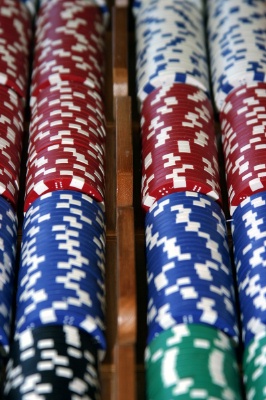|
|

Runner –
1. A chip runner
2. A card that completes a longshot two card draw.
A “Runner” is a slang term for a chip runner. Depending upon the casino you are playing in, a chip runner may also be called
“The Brush,” or an “Assistant to the
Floorman.” A chip runner’s primary responsibility
is to make sure that the dealer and all players get chips quickly when they need them.
If chips are not available when they are needed, it can slow down or stop the action. The dealer may be forced to stop running the
game for a few moments, to sell chips from his tray or to make change from bills. Some casinos do not allow bills to play, and they
may also restrict dealers from selling chips from their tray. In these cases, when chips are not available on time, the game can stop
completely until chips arrive. The house wants to prevent this from happening. Since they typically make their money by taking a
collection from each pot, if the action slows or stops, it costs them revenue. It is also bad for the game for the action to falter.
It is annoying for the players, because most of them want to gamble and will prefer fast action to slow action. If the game slows or
stalls, it is said to “have a flat tire.” Many players do not want to deal with a game if it has a flat tire, and they may even choose
to change tables or go home for the day if the problem persists. Management understands this and is keen to prevent slowdowns or
stoppages in the action. In fact, keeping the action going smoothly is so important that floormen are taught that their first priority
is to keep the action going at all times, and to never let the game stall. A stalled game takes priority over most other incidents
that regularly occur on the poker floor.
Since the house is so keen on keeping the action going smoothly, they hire chip runners, who give the game the liquidity it needs.
Chip runners often help to seat players, and they also sell chips to them upon their entry into the game. Chip runners also keep the
dealers supplied with enough chips to run the game. Chip runners are also responsible for quickly replenishing a player’s stack when
they wish to rebuy. As you can imagine, the house has a
vested interest in making sure that all player rebuys happen quickly and smoothly.
Chip runners are also available to assist players with player banks,
markers, and credit. They can usually help to facilitate any
cashier transaction without requiring that the player actually go to the cage. This allows the players to spend their time playing in
the game rather than standing in line for the cage. Depending upon the scope of their responsibilities at any given casino, the job of
chip runner can also include assisting the players or casino employees in any number of additional ways. Like many service oriented
positions within the casino, runners work for tokes, and if they provide you with some service, it is traditional to provide them with
a small gratuity, usually a dollar or two in chips.
The term “runner” is also frequently used in the context of a “runner-runner” draw. A runner-runner draw can be thought of as a
draw to a draw, or a draw that takes two cards and two betting rounds to complete. The term is frequently used in Texas Hold’em games,
when a player flops a draw that requires them to hit on both the turn and the river in order for them to complete their hand. Because
runner runner draws take two cards to complete rather than only one, the odds of hitting one is much lower that the odds of hitting a
one card draw. You can easily see this is the case if you compare the odds of completing a flush draw on the flop with the odds of
completing a runner-runner flush draw. If a player holds two suited cards, and the flop comes with two of their suit, they have
flopped a flush draw. Since they have four to a flush on the flop, they need only to hit a fifth card of their suit on either the turn
or the river, in order to complete their hand. This will happen about 38% of the time. Now, compare that to a situation where a player
holds two suited cards, but only one of their suit flops. In this situation, the player would have to hit his suit on both the turn
and the river in order to complete a runner-runner flush. This will only occur about 5% of the time, far less than the flush draw’s
38% completion rate.
Since runner runner draws are such longshots, it is a sign of poor play to take them routinely. In order to assess whether a draw is
worth taking, you should evaluate whether pot odds or implied odds exist. They rarely do exist for draws which require running cards,
unless some other draw also exists. If you chase runner runner and hit your hand, you are likely to receive some criticism for your
play.
Sometimes, you will start out taking one draw on the flop, but as the hand develops, you will find yourself on a secondary,
runner-runner draw as well. This is called a “back door”
draw, or a “back door runner-runner” draw. Backing into this type of draw is not necessarily a sign of poor play, so long as you had pot
odds or implied odds each time you made a call during the play of the hand.
Usage: Toke The Chip Runner, Runner-Runner Full House, Running Cards, Running Chips
Previous Poker Term: Royal Flush
Next Poker Term: Rush
|
|









